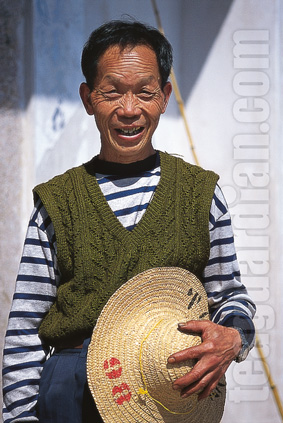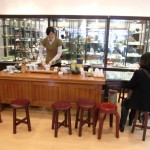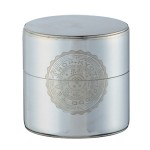Traditional Oolong Production: A Showcase

Master Wen of Wudong, 84 at the time of photo, who has just worked throughout the night to process the batch of Fenghuang Dancong we photographed in the tea massage photo
The rattling becomes more rigourous after each interval, and the “pang qing” (holding the leaves to make them bump into each other) becomes “yao qing”, i.e bumping turns “rock and roll”.
This stage of zao qing is critical in order for the leaves to attain an optimum condition for further processes to develop the aromas and tastes typical of these oolong teas. Since the weather, both before and during the plucking, and the conditions during sun-drying, temperature, and humidity are all variables that affect the quality of the leaves, the extent and control of rolling will need to be accordingly adjusted in order to maximize the result of the harvest. It takes a great deal of experience to be able to judge the leaves in the process to fine-tune subsequent work carried on them.
By breakfast time, the tea master makes a decision as to whether the tealeaves are ready for the next step, “sha qing” (killing of the green), i.e. arresting the fermentation of the leaves with heat.
roasting and twisting

Loosening of the twisted tea for the next stage. The green structure in the background is the base to a most popular twisting machine used locally, and is the most automatic part of the process. The twisted leaves fall through the rectangular spout (in the shadow near the middle of the photo) onto the basket below.
The fermented leaves is roasted at a temperature of about 200°C for a few minutes, being turned very briskly to avoid over heating. It’s rather like stir-frying vegetable, without the oil.
The application of heat also significantly reduces the water content, making the leaves soft and ready for twisting. Premium Phoenix oolongs are twisted tightly for an easy but gradual release of its flavor. While most small estates now employ small machines to carry out the twisting process, some productions are still twisted additionally with the hand. The pressure forces the oils and the juices to surface, which will turn into key flavour elements when they are baked in the next step.
firing
After the tea is twisted, it will be baked four times for five to ten minutes each time and with rests of one to two hours in between. The temperature is decreased from 120°C for the first baking to 60°C for the final one. The tea master may further twist the leaves to satisfy his requirements of taste before the final bake. The tea now is called “mao cha” (crude tea, i.e. it is almost like the final tea).
sorting and finishing bake
Each batch of mao cha is hand-sorted for twigs, broken and unprocessed leaves, etc. The batch is then baked for complete drying and ready to sell. Classic styles would be baked with extended time for the desired baked finish, some more respected producers still use charcoal ash for the process, as in tradition. In some really fine classic style varieties, such as a Milan Xiang from Wudong, where some leaf enzymes are still alive after the process, there is a second finishing bake around Mid-Autumn in the same year to heighten the tea’s taste potential and to make sure the tea can be kept for maturity.

Our local driver taking the opportunity to stretch out on the grass at the peak in Wudong while we are busy visiting gardens and tea trees
an observation
All acceptable quality Phoenix oolongs have to be processed immediately after plucking in order to maintain and seal-in the freshness and natural goodness. There is no centralized gathering of the harvest for transportation to a centrally controlled factory. Nor piling up of leaves to maximize utilization of machine capacity. Instead, production is a traditional craft that is carried out among local tea masters in individual family-based tea gardens.
By end of April through May, dealers and fans from all over China gather in key production areas, especially in Wudong, the mecca of the finest oolong in the Phoenix area, to bid for the best batches. Lines form in front of the tiny houses of all known quality makers.
The advantage of small farms is fully manifested here where the economic benefits of the trade is shared with the makers by way of demand of quality. Scale and full automation are obsolete because they cannot deliver the same thing to the market. Skills and experience are key production resources. I think this gives the world an insight into what fairness in trading can really mean and an alternative route to capitalize on otherwise excessive labour.











Thank you for a very good question. People do sell what they have right away to guarantee cash flow. And there are those who are eager to get the tea as fresh as possible. Some people pay directly to the farmers for the mao cha which they do not know there is still processing needed. So you get the idea.
Only very traditional dealers with the knowledge would do the proper post-mid-autumn bake. Firstly, it is against the Mainland China mentality to not make money while you the goods. Secondly, it takes care and skills in the complete process. Not many people still have them.
All harvests of Milan Xiang of respectable quality are only from Spring, and not summer or autumn. That means if you get a batch of it during autumn and the dealer tells you that it is freshly produced, either it is a lie or it is of poor quality. Or both. In Wudong or other famed regions in Phoenix, they only harvest once a year for Milan Xiang.
Great article, thank you! I didn’t know about the mid-autumn finishing bake for Milan Xian (my favorite of oolongs). Do the farmers keep this tea for half a year, or may sell it in spring/summer with just one finishing bake? And if it’s the latter, then does a summer batch of Milan Xian not retain its taste for as long as the autumn batch that have undergone the second finishing bake?